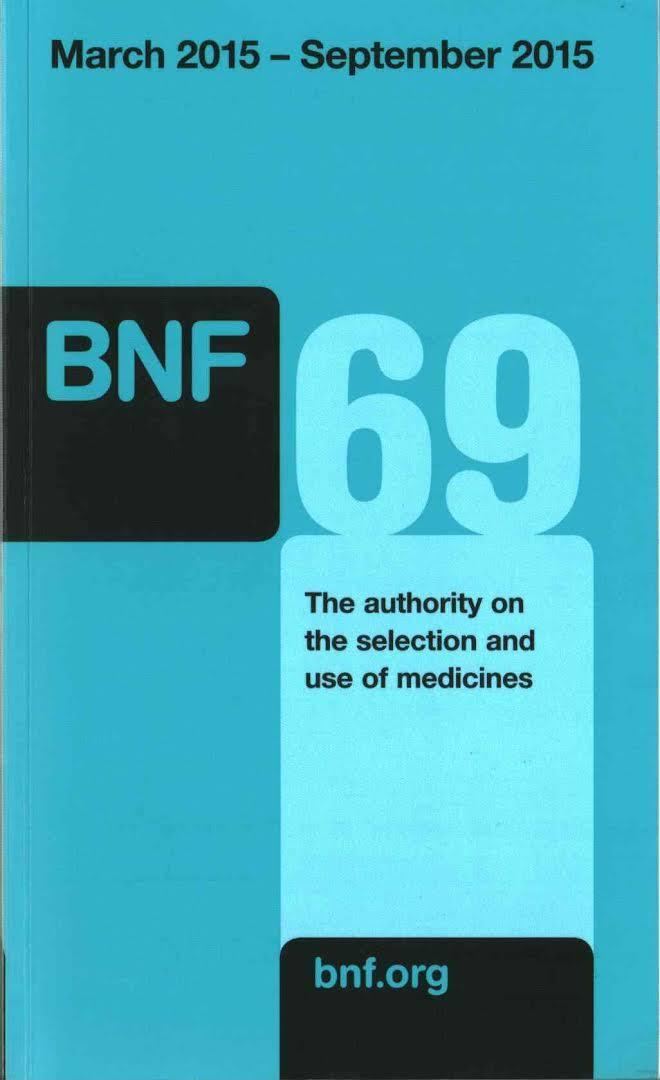Originally published 1949 OCLC 299701920 | ISBN 978-0-85711-273-6 Country United Kingdom | |
 | ||
Genre Clinical Pharmacy reference Publication date September 2016 – 72nd edition Media type Paperback print, digital online, smartphone app Similar Pharmacopoeia books, Other books | ||
The British National Formulary (BNF) is a United Kingdom (UK) pharmaceutical reference book that contains a wide spectrum of information and advice on prescribing and pharmacology, along with specific facts and details about many medicines available on the UK National Health Service (NHS). Information within the BNF includes indication(s), contraindications, side effects, doses, legal classification, names and prices of available proprietary and generic formulations, and any other notable points. Though it is a national formulary, it nevertheless also includes entries for some medicines which are not available under the NHS, and must be prescribed and/or purchased privately. A symbol clearly denotes such drugs in their entry.
Contents
It is used by pharmacists and doctors (both general practitioners (GPs) and specialist practitioners), and by other prescribing healthcare professionals (such as nurses, pharmacy technicians, paramedics, and dentists); as a reference for correct dosage, indication, interactions and side effects of drugs. It is also used as a reassurance by those administering drugs, for example a nurse on a hospital ward, and even for patients and others seeking an authoritative source of advice on any aspect of pharmacotherapy.
The British Pharmacopoeia (BP) specifies quality standards for the making of drugs listed in the BNF.
Development
Many individuals and organisations contribute towards the preparation of the BNF. It is jointly authored by the British Medical Association (BMA) and the Royal Pharmaceutical Society; and is jointly published by the BMJ Group (which is owned by the BMA), and the Pharmaceutical Press (owned by the Royal Pharmaceutical Society). It is published under the authority of a Joint Formulary Committee (JFC), which comprises representatives of the two professional bodies, and the Department of Health (DoH).
Information on drugs is drawn from the manufacturers' product literature, medical and pharmaceutical literature, regulatory authorities and professional bodies. Advice is constructed from clinical literature, and reflects, as far as possible, an evaluation of the evidence from diverse sources. The BNF also takes account of authoritative national guidelines and emerging safety concerns. In addition, the Joint Formulary Committee takes advice on all therapeutic areas from expert clinicians; this ensures that the BNF's recommendations are relevant to practice. However, in September 2013, the National Institute for Health and Care Excellence (NICE) in the UK opened a consultation on its draft decision not to give NICE accreditation to the processes to produce BNF publications following a review by an independent advisory committee.
History
It was first published in 1949 as the National Formulary, with updated versions appearing every three years until 1976. The fifth version in 1957 saw its name change to The British National Formulary. A new look version was released in 1981. A study in Northern Ireland looking at prescribing in 1965, reported that the BNF was likely able to serve the requirements of prescribers in general practice, while also achieving a cost saving. By 2003, issue 46 of the BNF contained 3000 interactions or groups of interactions, with about 900 of these marked by a bullet.
Editions
A new edition of the BNF book is published twice-yearly; in March and September. As of September 2016, the current edition is 72, which was published in September 2016. It is a customary tradition that the colour of each new edition is radically different from the previous.
Availability
The BNF is presently available as a book, a website, and mobile applications - the latter for use on smartphones and tablets. The book is available for purchase, and the September edition is distributed to healthcare professionals in the UK at no direct cost to them. NHS workers and healthcare professionals in the HINARI group of developing nations are entitled to free access via MedicinesComplete following registration (requires provision of a name, an address, an email address, and a phone number). Other visitors can subscribe to the BNF on MedicinesComplete. Healthcare organisations can also subscribe to a customisable BNF via their corporate online intranet. In June 2012, the National Institute for Health and Care Excellence (NICE) released applications for offline access to the BNF on iOS and Android devices. An NHS Athens log-in is required to use this application, and monthly content updates are available, over an internet connection.
Sister publications
The British National Formulary for Children (BNFC) book, first published September 2005, is published yearly, and details the doses and uses of medicines in children from neonates to adolescents.
The Nurse Prescriber's Formulary for Community Practitioners (NPF) is issued in print every two years (September, odd-numbered years), for use by District Nurses and Specialist Community Public Health Nurses (including Health Visitors) who have received training to become nurse prescribers.
BNF sections
The British National Formulary is divided into various sections; with the main sections on drugs and preparations being organised by body system.
- Gastro-intestinal system
- Cardiovascular system
- Respiratory system
- Nervous system
- Infection
- Endocrine system
- Genito-urinary system
- Malignant disease
- Blood and nutrition
- Musculoskeletal system
- Eye
- Ear, nose, and oropharynx
- Skin
- Vaccines
- Anaesthesia
- Emergency treatment of poisoning
